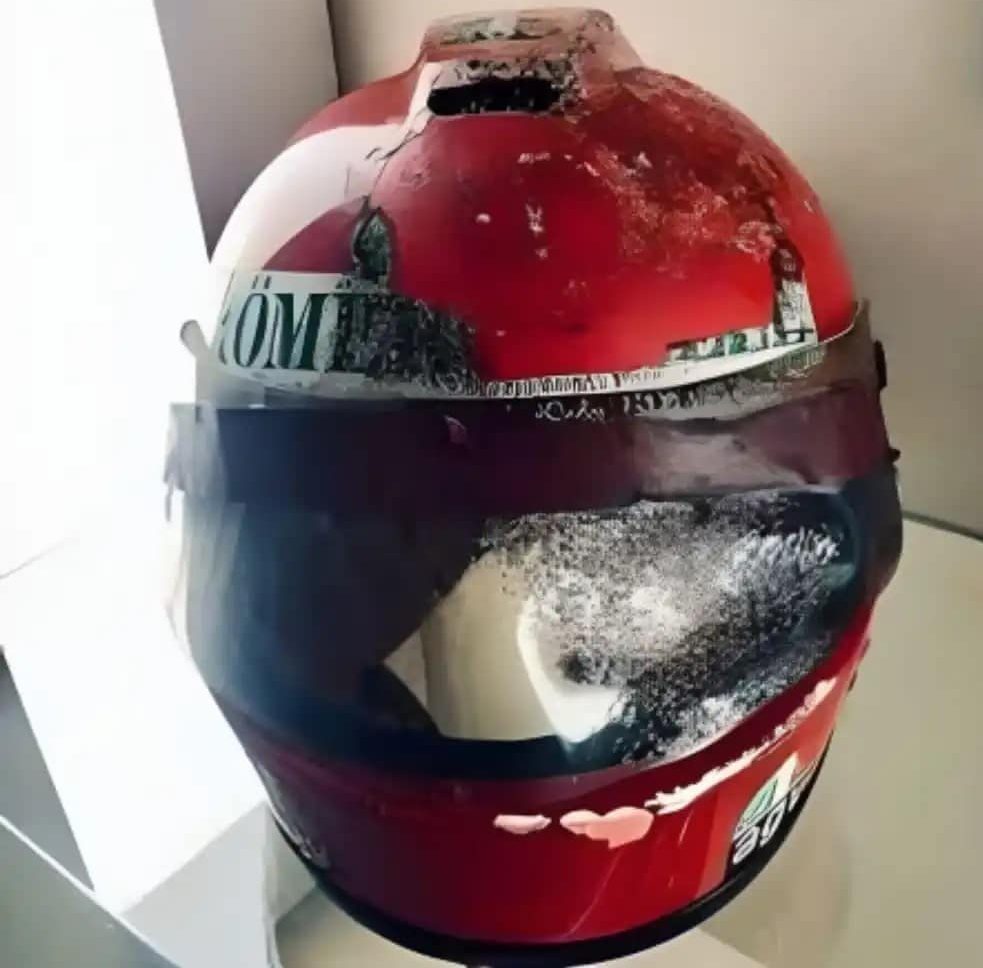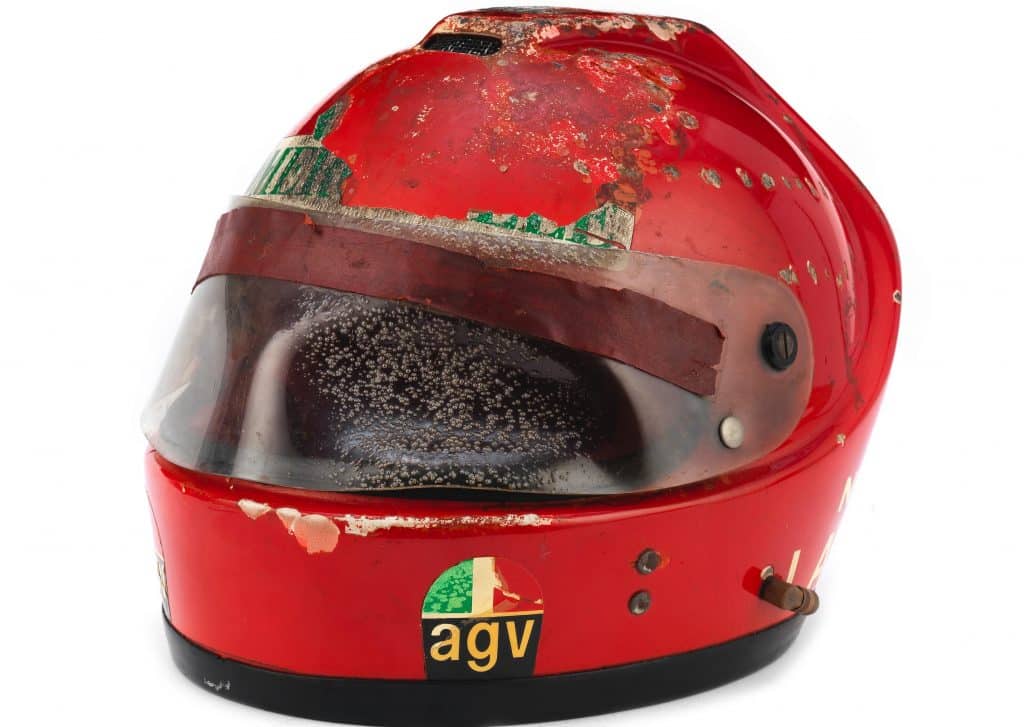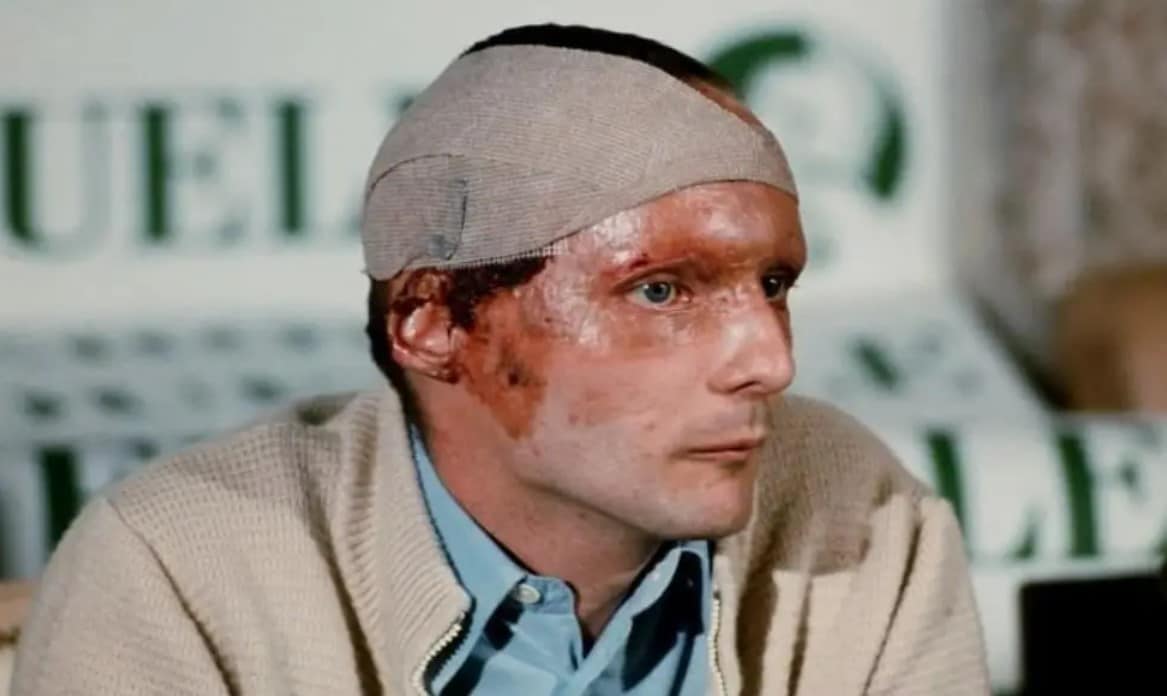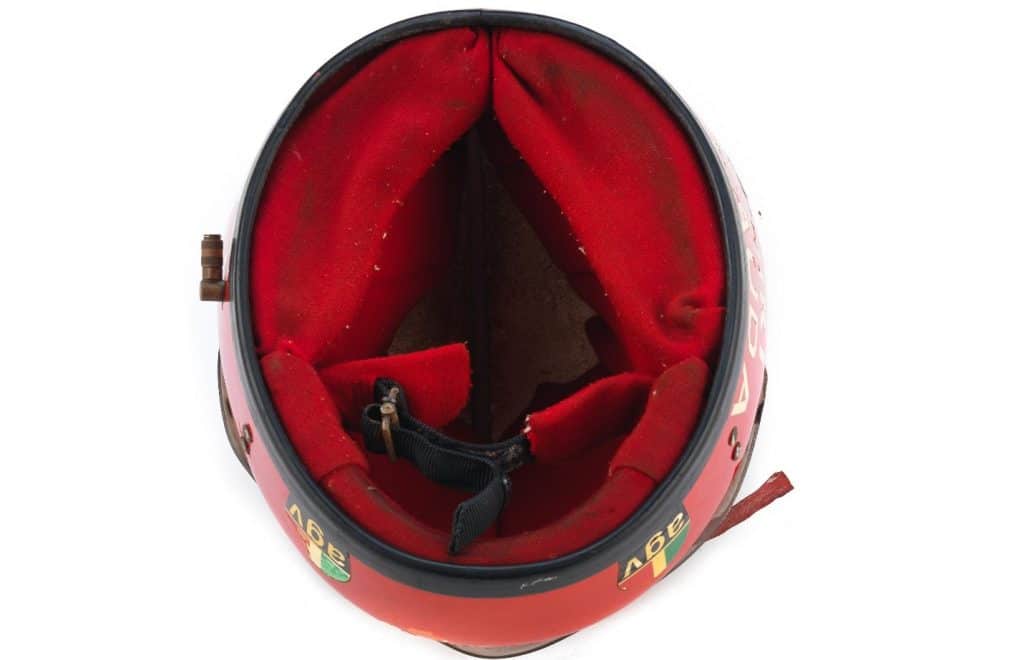On Saturday, May 4, 2024, an unprecedented event unfolds as the iconic AGV X1 helmet, worn by the three-time Formula 1 champion Niki Lauda (Andreas Nikolaus Lauda) during his harrowing 1976 Nürburgring crash, goes up for public auction by Bonhams at next week’s Miami Grand Prix for the very first time, coinciding with the 48th anniversary of the incident and the fifth anniversary of Lauda’s passing in 2019.


Niki Lauda’s Historic Helmet Up for Auction
And now, after a decade of been privately held in F1 memorabilia collections, anticipation runs high as collectors and fans alike have a rare opportunity to own a tangible piece of Formula 1 history. Experts predict that the helmet, imbued with the spirit of Lauda’s remarkable career and the resilience he embodied, could fetch between $50,000 to $60,000. With a portion of the proceeds earmarked for donation to UNICEF to aid vulnerable children worldwide, Niki Lauda’s son, Lukas Lauda, expressed,
“We’re pleased that our father’s enduring legacy continues to provide aid to those most in need. UNICEF faces significant challenges in delivering humanitarian assistance to children globally. If our contribution can help improve prospects for others, we are gratified to play a part.”
James Garguilo, Cars Automobilia Specialist for Bonhams, added,
“We consider it a privilege to present this historically significant helmet, serving as a testament to Niki Lauda’s enduring legacy as both a driver and a tireless advocate for driver safety. His unwavering determination and remarkable courage have forever altered the course of racing history.”
Historical Significance of the Lauda’s Helmet

Which Helmet Standard Is The Best? Snell, DOT, ECE, SHARP, Or FIM? We Rate All 5
AGV X1 helmet gained global recognition for its role in Lauda’s courageous ordeal, forever etching itself into the annals of racing history and solidifying the reputation of AGV helmets.

During the infamous Nürburgring Nordschleife race in August 1976, affectionately known as “The Ring,” (in the last few decades, it has become the ultimate proving ground for every hyper-Porsche and 200 mph Corvette around) Lauda, then 27, and his rival James Hunt started on the front row of the grid, intensifying their fierce competition in one of motorsport’s most legendary battles.

But despite pre-race safety concerns regarding the circuit’s daunting 14.19-mile length and the scarcity of marshals, the race proceeded following discussions among drivers. And as light rain descended, Lauda chose to start on wet-weather track tires, only to pit after the first lap to switch to dry tires.
During his second lap, negotiating a high-speed left kink before Bergwerk, Niki Lauda’s Ferrari 312T2 veered off course, ramming into the fencing and earth bank before crashing into Brett Lunger’s Surtees-Ford. The impact transformed both vehicles into twisted wreckage, engulfed in flames and billowing smoke.

While Lunger managed to escape from his car, Lauda found himself trapped in the fiery cockpit for nearly a minute until the swift actions of Arturo Merzario, Brett Lunger, Guy Edwards, and Harald Ertl facilitated his rescue and transportation to the hospital.
The impact of the collision was so severe that Lauda’s helmet was dislodged, resulting in third-degree burns on his head and hands. He also suffered from inhaling toxic fumes, leading to lung and blood damage. In a poignant moment, Lauda was administered the Last Rites by a priest while in the hospital, an experience he later revealed deeply affected him, fueling his determination to survive.
Niki Lauda’s Remarkable Return

And so it came to pass that with the heart of a champion, Lauda persevered, defying the odds to make a triumphant return to the track at the Italian Grand Prix a mere 42 days after his harrowing incident, missing only two races. Remarkably, the day after his comeback, he secured an incredible fifth-place qualification, and despite facing 52 laps of F1 racing just six weeks after his brush with death, Lauda demonstrated his resilience by finishing fourth in that race.
But Lauda’s quest for the 1976 world championship ultimately ended in disappointment as he narrowly lost to Briton James Hunt by a solitary point. A heart-wrenching defeat that came after Lauda retired two laps into the final race of the season in Japan due to torrential conditions. Lauda’s vision had been significantly impaired by the accident, rendering him unable to see clearly.
The intense rivalry between Lauda and Hunt became the subject of the Hollywood film “Rush,” released in 2013. Starring Daniel Brühl as Niki Lauda and Chris Hemsworth as fellow driver James Hunt, the movie captured their legendary battles on the racetrack.

In the following year, in 1977, Lauda staged an impressive comeback, redeeming himself by clinching his second championship in his final season at Ferrari. And despite a brief hiatus from the sport, he returned to the pinnacle of Formula 1 in 1984, securing his third championship, halfway through a four-year tenure with McLaren.
Lauda’s Impact on Motorsport Safety and Legacy Beyond the Track

Many would agree with me that Lauda’s advocacy and campaigning efforts have played a pivotal role in driving significant advancements in safety measures and incident response protocols at racing events. Following his accident, the sport underwent a transformative shift, elevating driver safety to unprecedented levels. Lauda’s ordeal served as a tipping point, shaping the standards of safety in motorsport to the present day.
And before transitioning into entrepreneurship and founding his three airlines, Niki Lauda made significant contributions to the motorsport world.
But then, tragedy struck with Lauda Air Flight 004 (OE-LAV), a relatively young Boeing 767-3Z9ER operated by Lauda Air, one of Lauda’s ventures. Just 16 minutes after takeoff, the aircraft disintegrated mid-air and exploded over Phu Toei National Park, Suphan Buri Province, Thailand. The devastating incident resulted in the loss of all 223 individuals on board, comprising 213 passengers and 10 flight crew members. With only six planes leased, Lauda personally knew every member of his staff!

In 1985, during his second retirement from Formula One and while still at the helm of Lauda Air, he was appointed as a consultant at Ferrari. Here, he played a pivotal role in reviving the team under Montezemolo’s leadership, a contribution that would later influence Lewis Hamilton’s surprising transition to Mercedes from McLaren in 2013, during Lauda’s tenure as the non-executive chairman of Mercedes-Benz motorsport.
Following the sale of his shares in Lauda Air to Austrian Airlines in 1999, Lauda took the reins of the Jaguar Formula One racing team from 2001 to 2002. Later, in late 2003, he embarked on a new venture by launching Niki, an airline that eventually merged with its major partner Air Berlin in 2011. In the wake of Air Berlin’s insolvency in 2017, LaudaMotion, formerly known as Amira Air under his leadership, seized the opportunity to acquire the Niki brand and assets after Lufthansa and IAG’s unsuccessful bid.
Lauda, holding an airline transport pilot’s license, occasionally assumed the role of captain on flights operated by his airline.
AGV X1 Helmet Featured at Bonhams Cars Preview Tent in Miami

Back to the auction, the AGV X1 helmet, bearing witness to Lauda’s remarkable journey, will be prominently showcased in the Bonhams Cars preview tent at the Miami International Autodrome next week, ahead of its auction on Saturday, May 4.
Moreover, the AGV X1 holds a fascinating historical tie-in beyond Lauda’s iconic journey. It was also worn by Lella Lombardi, the only woman to ever rack up points in F1 history. She snagged half a point in the 1975 Spanish Grand Prix, and guess what? She’s from Valenza, Italy, the same region as AGV.
Also up for grabs at Bonhams’ Miami Grand Prix public auction will be helmets worn by other legendary Grand Prix drivers, including:
- Michael Schumacher’s Ferrari helmet worn during the 1997 Italian Grand Prix, estimated at $25,000-30,000.
- Nigel Mansell’s Ferrari helmet from the 1989/1990 season, estimated at $25,000-30,000.
- Gilles Villeneuve’s Ferrari helmet from the 1981/1982 season, estimated at $20,000-25,000.
- Alain Prost’s Ferrari helmet worn during the 1990 Italian Grand Prix, where he secured 2nd place, estimated at $15,000-20,000.
- Gerhard Berger’s Ferrari helmet from the 1995 season, estimated at $5,000-7,000.
- Jean Alesi’s Ferrari helmet from the 1995 season, estimated at $5,000-7,000.
- Eddie Irvine’s Ferrari helmet worn during the 1998 French Grand Prix, where he secured 2nd place, estimated at $5,000-7,000.
For more information about safety helmet standards please read this article:
Information for this press release was partially sourced and researched from the following authoritative government, educational, corporate, and non-profit organizations:
M/A













